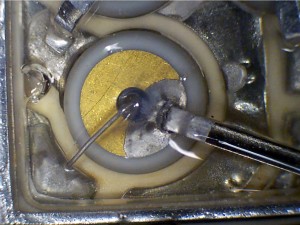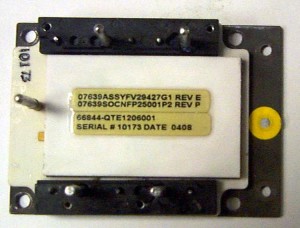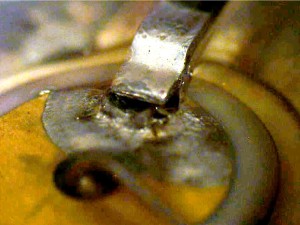SCR FP25001P1 or Thyristor Failure Analysis
Gideon Analytical Labs received one SCR (silicon-controlled rectifier) module FP25001P1 for failure analysis.
An SCR consists of four layers of alternating p- and n-type semiconductor materials, NPNP or PNPN structures. The three P-N junctions are labeled J1, J2 and, J3, for the three terminals. Silicon is used as the intrinsic semiconductor, to which the proper dopants are added. The junctions are either diffused or alloyed (an alloy is a mixed semiconductor or a mixed metal). The planar construction is used for low-power SCRs (and all the junctions are diffused). The mesa-type construction is used for high-power SCRs. In this case, junction J2 is obtained by the diffusion method, and then the outer two layers are alloyed to it since the PNPN pellet is required to handle large currents. It is properly braced thyristor. The term “thyristor” applies to the larger family of multilayer devices that exhibit bistable state-change behavior, that is, switching either on or off.
The anode terminal of an SCR is connected to the p-type material of a PNPN structure, and the cathode terminal is connected to the n-type layer, while the gate of the SCR is connected to the p-type material nearest to the cathode.
The device was tested and found that the gate was open in relationship to T+ on SCR1. SCR1 had melted solder at the lead frame interconnect of T+. This lead frame has lifted off the cathode surface. This happens when there is internal stress on the lead frame as a result of non-concurrent soldering. This lead was not soldered on the cathode sufficiently. This lead is not “wetted” properly. This is indicative of cold solder joints. The complimentary cathode solder shows a similar lack of “wetting.”
Sometimes failure analysis is not complicated; in this case, Gideon Labs was able to find the problem fairly quickly and pinpoint the problem on to the manufacturing vendor. Call Gideon Analytical Labs the next time you need failure analysis on SCRs.

SCR with interconnects

SCR Module

Lifted Cathode Lead

Poor Solder Wetting